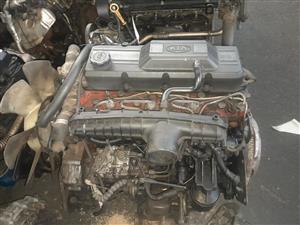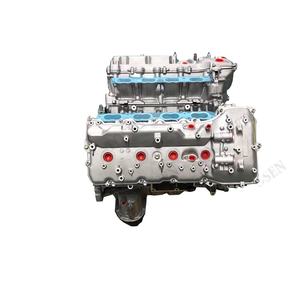Opel Corsa Engine: Whatever You Required to Know Prior To Purchasing
Checking Out the Inner Operation of a Compact Automobile's Engine System
As vehicle drivers, we usually take for granted the intricate procedures that happen within the confines of our lorry's engine system. In this expedition of a compact lorry's engine system, we will certainly unravel the internal functions of this mechanical symphony, dropping light on the mysteries that drive us ahead on our everyday trips.
Burning Process Summary
The combustion procedure in a compact car's engine system is a crucial mechanism that effectively converts fuel right into power to power the car. This process happens within the burning chamber of the engine, where gas and air mix, stir up, and produce regulated explosions. The burning procedure consists of 4 main stages: consumption, compression, exhaust, and power.
Throughout the intake phase, the piston relocates downward, drawing in a combination of air and gas into the burning chamber. The next phase, compression, includes the piston relocating up, compressing the air-fuel blend to enhance its effectiveness. Consequently, in the power stage, the stimulate plug ignites the pressed blend, resulting in a quick expansion of gases that compels the piston back down. This descending movement creates the power needed to drive the automobile. In the exhaust stage, the burnt gases are expelled from the combustion chamber via the exhaust valve, preparing the chamber for the next cycle. This cyclic burning process is basic to the procedure of a compact automobile's engine system, guaranteeing efficient power conversion for propulsion.
Piston and Cylinder Communication

The piston's exact fit within the cyndrical tube is vital for preserving optimal compression and avoiding energy loss throughout burning. Tight clearances between the piston and cyndrical tube walls guarantee efficient securing, enabling the piston to move smoothly without permitting gases to leak past. Proper lubrication is additionally crucial to decrease friction and use between these parts, improving longevity and efficiency.
Moreover, the design and products utilized in manufacturing the piston and cyndrical tube effect engine efficiency and resilience. Modern engines often use lightweight yet sturdy products like light weight aluminum alloys for pistons and cyndrical tube linings to minimize inertia and enhance thermal performance. In general, the unified interaction in between the piston and cylinder is basic to the engine's performance and total performance.
Gas Injection System Functionality
Gas shot systems in small lorry engines play an essential duty in precisely supplying fuel to the burning chamber for regulated and reliable ignition. The fuel shot system functions by infusing fuel right into the burning chamber at the optimal moment throughout the engine's operation (opel corsa engine). This accurate timing makes certain that the fuel mixes equally with the air for proper combustion, causing boosted fuel effectiveness and reduced exhausts
There are primarily read here two kinds of gas shot systems made use of in portable vehicle engines: port fuel injection (PFI) and direct fuel injection (DFI) PFI systems inject fuel into the intake port before the intake valve, while DFI systems inject fuel directly into the combustion chamber. Both systems have their benefits, with DFI supplying far better gas atomization and PFI giving a more cost-effective solution.
Understanding Engine Cooling Mechanisms
Efficient operation of a compact vehicle's engine relies greatly on the performance of its cooling devices. Engine air conditioning is crucial to protect against getting too hot, which can cause significant damages and reduced performance. The cooling system opel corsa engine in a compact lorry typically contains a number of components collaborating to control the engine temperature. One crucial component is the radiator, which utilizes coolant to take in heat from the engine. As the warm coolant streams through the radiator, it releases warmth into the air, cooling down prior to returning to the engine. The water pump circulates the coolant via the engine and radiator, making certain a constant flow to manage temperature. Additionally, the thermostat aids manage the coolant flow to preserve optimal engine temperature level. Some automobiles likewise have cooling down fans that turn on when additional air conditioning is required, such as throughout hefty traffic or heat. Recognizing these engine cooling devices is crucial for maintaining the performance and long life of a small lorry's engine system.

Exhaust System Components Explained
The optimal performance of a portable lorry's engine air conditioning systems depends on a corresponding system understood as the exhaust system, which comprises various essential components for making certain reliable discharges and engine performance. The exhaust manifold collects exhaust gases from the engine's cyndrical tubes and courses them to the catalytic converter.
One crucial part of the exhaust system is the oxygen sensing unit, which keeps an eye on the oxygen levels in the exhaust gases to aid manage fuel consumption and make certain ideal engine performance. opel corsa engine. In addition, the resonator might exist in some exhaust systems to reduce sound levels. On the whole, the exhaust system plays a crucial role in keeping engine effectiveness, reducing unsafe exhausts, and guaranteeing a quieter driving experience for portable car proprietors

Conclusion
To conclude, the small lorry's engine system is a complicated mix of components that interact to help with the burning process, convert gas into power, and expel waste gases. Comprehending the internal functions of the engine system, consisting of the piston and cylinder interaction, gas shot system, engine cooling systems, and exhaust system parts, is essential for keeping optimal performance and performance of the lorry.
The combustion process in a portable vehicle's engine system is an important device that efficiently converts fuel into power to power the lorry.Gas injection systems in compact car engines play an essential duty in precisely delivering fuel to the combustion chamber for effective and regulated ignition.There are mostly two types of fuel injection systems utilized in small automobile engines: port gas shot (PFI) and straight gas shot (DFI) Comprehending these engine air conditioning devices is essential for keeping the efficiency and long life of a portable automobile's engine system.
The optimum performance of a compact automobile's engine air conditioning systems depends on a complementary system known as the other exhaust system, which comprises various important components for guaranteeing efficient emissions and engine efficiency.